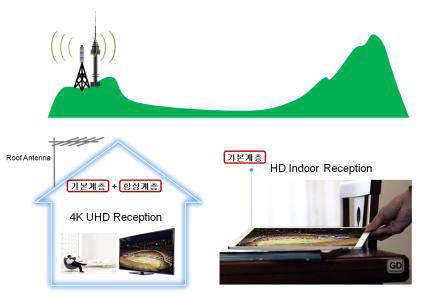KBS Technical Research Institute began to develop the ‘SHVC (Scalable HEVC)’ technology that can improve the efficiency of image data compression by 20% in preparation for the HEVC (high-efficiency compression coding) independent encoding.
It is planning to not only invigorate the 4K (3840×2160) UHD broadcasting service based on SHVC, but also prepare for the age of 8K (7680×4320) UHD broadcasting that will come our way in the future.
KBS Technical Research Institute recently selected the ‘4K UHD TV layered encoder/decoder’ as a new R&D project, and began searching for a partner that will jointly research and develop the SHVC codec.
The SHVC technology, standardized last July, encodes HD and 4K UHD data as the base layer and enhancement layer respectively. It can improve compression efficiency by about 20% compared to independently encoding HD and 4K UHD with HEVC.
“If SHVC is combined with the layered transmission technology, it will be possible to secure compatibility with existing compression technologies as well as the high compression efficiency of HEVC,” said industry insiders. “It is a core technology that will prepare us for not only the HD and 4K UHD broadcasting service, but also the 4K and 8K UHD broadcasting service.”
KBS Technical Research Institute is planning to develop the HD and 4K UHD service combining SHVC and the layered transmission technology in this project. Its goal is to have the SHVC technology encode the HD and 4K UHD data in a single stream, and thus create an environment where viewers can selectively watch HD or 4K UHD depending on their reception environment.
It will also try to find ways to output MPEG-2 and H.264/AVC, the existing compression technologies, with the SHVC commercial encoder. HEVC, which is mostly used for production of UHD contents, has been incompatible with other video compression technologies if it is applied to terrestrial digital broadcasting service.
“We are paying attention to the method of using the (SHVC) commercial encoder output for layered encoding when MPEG-2 or H.264/AVC is used for the base layer,” said KBS Technical Research Institute in its research project RFP. “We will be able to easily build an additional 4K UHD broadcasting infrastructure without greatly modifying the existing digital broadcasting system”.
